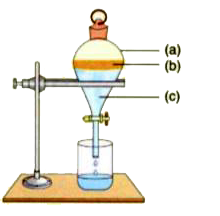On what priciple are the following methods of separation based? Give on example of a mixture of the methods mentioned in which they are used.
Sedimentation and decantation.
Step-by-Step Solution:
1. Understanding Sedimentation:
- Sedimentation is the process where heavier, insoluble particles in a liquid settle down to the bottom when the mixture is left undisturbed. This occurs due to the force of gravity acting on the particles.
- Example: In a mixture of sand and water, when left undisturbed, the sand (being heavier) will settle at the bottom of the container, while the water remains on top.
2. Identifying Sediments and Supernatant Liquid:
- The particles that settle at the bottom are called sediments, while the clear liquid above them is referred to as the supernatant liquid.
- In our example, the sand at the bottom is the sediment, and the clear water on top is the supernatant liquid.
3. Understanding Decantation:
- Decantation is the process of carefully pouring off the clear liquid from the top of the sediment without disturbing the settled particles at the bottom.
- Example: After allowing the sand and water mixture to settle, we can pour the clear water into another container, leaving the sand behind.
4. Combining the Processes:
- Sedimentation and decantation are often used together to separate mixtures of solids and liquids. First, sedimentation allows the solid particles to settle, and then decantation allows for the removal of the liquid without disturbing the settled solids.
- Example in Context: In the sand and water mixture, sedimentation allows the sand to settle, and decantation allows us to pour off the water, effectively separating the two components.
5. Conclusion:
- The principle behind sedimentation and decantation is based on the differences in density between the solid particles and the liquid. Heavier particles settle down due to gravity, and the clear liquid can be poured off without disturbing the settled solids.
---
- Sedimentation is the process where heavier, insoluble particles in a liquid settle down to the bottom when the mixture is left undisturbed. This occurs due to the force of gravity acting on the particles.
- Example: In a mixture of sand and water, when left undisturbed, the sand (being heavier) will settle at the bottom of the container, while the water remains on top.
- The particles that settle at the bottom are called sediments, while the clear liquid above them is referred to as the supernatant liquid.
- In our example, the sand at the bottom is the sediment, and the clear water on top is the supernatant liquid.
- Decantation is the process of carefully pouring off the clear liquid from the top of the sediment without disturbing the settled particles at the bottom.
- Example: After allowing the sand and water mixture to settle, we can pour the clear water into another container, leaving the sand behind.
- Sedimentation and decantation are often used together to separate mixtures of solids and liquids. First, sedimentation allows the solid particles to settle, and then decantation allows for the removal of the liquid without disturbing the settled solids.
- Example in Context: In the sand and water mixture, sedimentation allows the sand to settle, and decantation allows us to pour off the water, effectively separating the two components.
- The principle behind sedimentation and decantation is based on the differences in density between the solid particles and the liquid. Heavier particles settle down due to gravity, and the clear liquid can be poured off without disturbing the settled solids.
Topper's Solved these Questions
- BOOK - ICSECHAPTER - ELEMENTS COMPOUNDS AND MIXTURES. EXERCISE - OBJECTIVE TYPE QUESTIONS (FIIL IN THE BLANKS )10videos
ELEMENTS COMPOUNDS AND MIXTURES.
- BOOK - ICSECHAPTER - ELEMENTS COMPOUNDS AND MIXTURES. EXERCISE - OBJECTIVE TYPE QUESTIONS (MULTIPLE CHOICE QUESTIONS)5videos
ELEMENTS COMPOUNDS AND MIXTURES.
- BOOK - ICSECHAPTER - ELEMENTS COMPOUNDS AND MIXTURES. EXERCISE - OBJECTIVE TYPE QUESTIONS (MULTIPLE CHOICE QUESTIONS)5videos
ELEMENTS COMPOUNDS AND MIXTURES.
- BOOK - ICSECHAPTER - ATOMS, MOLECULES AND RADICALSEXERCISE - State the term for the following5videos
ATOMS, MOLECULES AND RADICALS
- BOOK - ICSECHAPTER - LANGUAGE OF CHEMISTRY EXERCISE - OBJECTIVE TYPE QUESTIONS (MULTIPLE CHOICE QUESTIONS)6videos
LANGUAGE OF CHEMISTRY
Similar Questions
On what priciple are the following methods of separation based? Give on example of a mixture of the methods mentioned in which they are used.
SublimationsView SolutionOn what priciple are the following methods of separation based? Give on example of a mixture of the methods mentioned in which they are used.
Filtration.View SolutionOn what priciple are the following methods of separation based? Give on example of a mixture of the methods mentioned in which they are used.
Magnetic separations.View SolutionOn what priciple are the following methods of separation based? Give on example of a mixture of the methods mentioned in which they are used.
Solvent extraction methodView SolutionOn what priciple are the following methods of separation based? Give on example of a mixture of the methods mentioned in which they are used.
By using a separating funnelView SolutionOn what priciple are the following methods of separation based? Give on example of a mixture of the methods mentioned in which they are used.
Fractional distillations.View Solution
Give one example of a mixture which can be separated using this method.View SolutionWhich of the following methods can be used to separate mustard oil and water from a mixture of the two?
View SolutionWhich of the following method is used during abortion ?
View SolutionWhich of the following method is used during abortion ?
View Solution

